Economic Freedom of the World
economic-freedom-of-the-world-2016
economic-freedom-of-the-world-2016
Create successful ePaper yourself
Turn your PDF publications into a flip-book with our unique Google optimized e-Paper software.
Appendix: Explanatory Notes and Data Sources • 277<br />
I Business costs <strong>of</strong> crime<br />
This component is from <strong>the</strong> Global Competitiveness Report question: “To what extent<br />
does <strong>the</strong> incidence <strong>of</strong> crime and violence impose costs on businesses in your country?<br />
(1 = To a great extent; 7 = Not at all)”.<br />
Source<br />
<strong>World</strong> <strong>Economic</strong> Forum, Global Competitiveness Report.<br />
Area 3 Sound Money<br />
A Money growth<br />
The component measures <strong>the</strong> average annual growth <strong>of</strong> <strong>the</strong> money supply in <strong>the</strong> last<br />
five years minus average annual growth <strong>of</strong> real GDP in <strong>the</strong> last ten years. Countries<br />
where growth <strong>of</strong> <strong>the</strong> money supply greatly exceeds growth <strong>of</strong> real output receive lower<br />
ratings. The M1 money supply (basically defined as checkable deposits plus currency<br />
in circulation) figures were used to measure <strong>the</strong> growth rate <strong>of</strong> <strong>the</strong> money supply. The<br />
rating is equal to: (V max − V i ) / (V max − V min ) multiplied by 10. V i represents <strong>the</strong> average<br />
annual growth rate <strong>of</strong> <strong>the</strong> money supply during <strong>the</strong> last five years adjusted for <strong>the</strong><br />
growth <strong>of</strong> real GDP during <strong>the</strong> previous ten years. The values for V min and V max were<br />
set at zero and 50%, respectively. Therefore, if <strong>the</strong> adjusted growth rate <strong>of</strong> <strong>the</strong> money<br />
supply during <strong>the</strong> last five years was zero, indicating that money growth was equal<br />
to <strong>the</strong> long-term growth <strong>of</strong> real output, <strong>the</strong> formula generates a rating <strong>of</strong> 10. Ratings<br />
decline as <strong>the</strong> adjusted growth <strong>of</strong> <strong>the</strong> money supply increases toward 50%. When <strong>the</strong><br />
adjusted annual money growth is equal to (or greater than) 50%, a rating <strong>of</strong> zero results.<br />
Sources <strong>World</strong> Bank, <strong>World</strong> Development Indicators; International Monetary Fund,<br />
International Financial Statistics; United Nations National Accounts.<br />
B Standard deviation <strong>of</strong> inflation<br />
The component measures <strong>the</strong> standard deviation <strong>of</strong> <strong>the</strong> inflation rate over <strong>the</strong> last<br />
five years. Generally, <strong>the</strong> GDP deflator was used as <strong>the</strong> measure <strong>of</strong> inflation for this<br />
component. When <strong>the</strong>se data were unavailable, <strong>the</strong> Consumer Price Index was used.<br />
The following formula was used to determine <strong>the</strong> zero-to-10 scale rating for each<br />
country: (V max − V i ) / (V max − V min ) multiplied by 10. V i represents <strong>the</strong> country’s<br />
standard deviation <strong>of</strong> <strong>the</strong> annual rate <strong>of</strong> inflation during <strong>the</strong> last five years. The values<br />
for V min and V max were set at zero and 25%, respectively. This procedure will allocate<br />
<strong>the</strong> highest ratings to <strong>the</strong> countries with <strong>the</strong> least variation in <strong>the</strong> annual rate <strong>of</strong><br />
inflation. A perfect 10 results when <strong>the</strong>re is no variation in <strong>the</strong> rate <strong>of</strong> inflation over<br />
<strong>the</strong> five-year period. Ratings will decline toward zero as <strong>the</strong> standard deviation <strong>of</strong><br />
<strong>the</strong> inflation rate approaches 25% annually.<br />
Sources <strong>World</strong> Bank, <strong>World</strong> Development Indicators; International Monetary Fund,<br />
International Financial Statistics.<br />
C Inflation: most recent year<br />
Generally, <strong>the</strong> CPI was used as <strong>the</strong> measure <strong>of</strong> inflation for this component as it is<br />
<strong>of</strong>ten available before <strong>the</strong> GDP deflator is available. When <strong>the</strong>se data were unavailable,<br />
<strong>the</strong> GDP deflator inflation rate was used. The zero-to-10 country ratings were derived<br />
www.free<strong>the</strong>world.com • www.fraserinstitute.org • Fraser Institute ©2016


